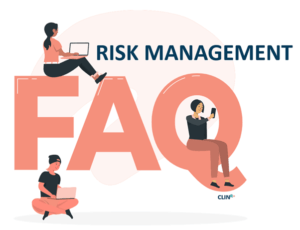Risk Management FAQs

Q: How is risk defined in the context of medical devices?
A: In the context of medical devices, risk is defined as the combination of the probability of harm occurring and the severity of that harm. It encompasses the potential dangers associated with a medical device and the potential impact on patients, users, and other stakeholders. It should be noted that hazards refer to the device deficiencies whereas harms refer to the adverse event presentation in the patient. It is important to make this distinction as hazards do not relate as a risk unless they present as a harm in a person (patient, user, or the general public).
Q: What ISO should be used for medical device Risk Management?
A: ISO 14971 is an international standard that specifies the requirements for medical device risk management systems. It provides guidelines and best practices for managing risks throughout the entire life cycle of a medical device. Compliance with ISO 14971 is crucial for bringing safe and compliant medical devices to the market.
Q: What are some key requirements for implementing a risk management system complying with ISO 14971?
A: According to ISO 14971, key requirements for implementing a risk management system include:
- Having top management support and allocating the necessary resources for risk management activities.
- Defining a risk policy that establishes criteria for risk acceptability.
- Conducting ongoing processes to identify hazards, estimate and evaluate risks, control risks, and monitor the effectiveness of risk control measures.
- Developing a risk management plan specific to each device or device family, outlining the steps and methods to manage risks.
- Assembling a qualified risk management team that has the necessary expertise and knowledge related to the device being developed.
- Using risk analysis tools and methodologies to identify and assess risks associated with various aspects of the device’s life cycle.
- Weighing the risks against the benefits of the device and ensuring that the benefits outweigh the residual risks.
- Reviewing the outcomes of risk management activities, documenting the findings, and creating a comprehensive report.
- Establishing a risk monitoring plan to continuously evaluate and mitigate risks throughout the device’s life cycle.
Q: How does ISO 14971 relate to regulatory requirements for medical devices?
A: ISO 14971 is widely recognized and referenced by regulatory authorities around the world. It aligns with regulatory requirements for medical devices, including the Quality System Regulation of the FDA in the United States and the Medical Device Regulation (MDR) in Europe. Compliance with ISO 14971 helps demonstrate adherence to risk management requirements specified in national regulations and international standards.
Q: What are some challenges in implementing a risk management system?
A: Implementing a risk management system for medical devices can be challenging due to various factors, including the complexity and diversity of risks associated with different devices, the lack of real-world data to accurately quantify risks (especially for new devices), and the need to continuously monitor and update risk assessments throughout the device’s life cycle. Additionally, ensuring cross-functional collaboration and obtaining necessary expertise from clinical affairs, engineering, and quality management can be challenging but is essential for effective risk management.
Q: Why do manufacturers need risk management?
A: Risk management plays a crucial role in ensuring the safety and efficacy of medical devices. By systematically identifying, evaluating, controlling, and monitoring risks throughout the device’s life cycle, risk management helps mitigate potential harm to patients, users, and other stakeholders. Compliance with risk management standards, such as ISO 14971, helps demonstrate a proactive approach to managing risks and ensures that devices meet regulatory requirements for safety and effectiveness.
